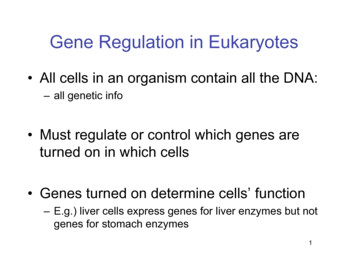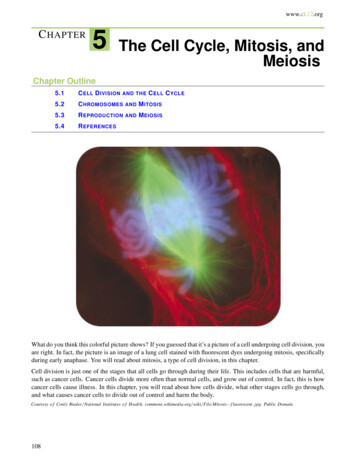
Transcription
Chapter 5:THE EUKARYOTES OF MICROBIOLOGY1. Unicellular Eukaryotic Parasites2. Parasitic Helminths3. Fungi4. Algae & Lichens
New Classification ofthe Domain EukaryaThe domain Eukarya hasundergone major reclassificationbased on 6 IZARIAAMOEBOZOAOPISTHOKONTA
1. Unicellular Eukaryotic ParasitesMembers of the supergroups:AMOEBOZOAEXCAVATACHROMALVEOLATA
Unicellular Parasites in the AmoebozoaMembers of this supergroup extend pseudopodia andexhibit motility by amoeboid movement, and feed byphagocytosis.We will look at examples of parasites in the subgroup:ENTAMOEBAS
EntamoebasEntamoeba histolytica typically transmitted bycontaminated, untreated water leads to amoebic dysenteryNaegleria fowleri typically transmitted bycontaminated water via nose “brain-eating amoeba, almostalways fatal
Unicellular Parasites in the ChromalveolataWe will look at examples of parasites in the subgroups:APICOMPLEXANSCILIATES
Apicomplexans non-motile obligate intracellular parasites have a unique “apical complex” of fibers and vacuoles thatrelease digestive enzymes that aid penetration of animal tissues includes species of Plasmodiumresponsible for the disease malaria reproduce asexually by schizoganyNucleusschizogonyMultiple mitosesSchizontMerozoitesCytokinesisPlasmodium Vivax(inside RBCs)
Plasmodium LifeCycle (malaria) definitive host(sexual reproduction)is the mosquito intermediate host(asexual reproduction)is Homo sapiensmeiosis
CiliatesParameciumAll have many small projections called cilia used for locomotion & todirect food into the cytostome (“mouth”) have contractile vacuole to expel excess watertaken in by osmosis (expelled by exocytosis) some have multiple nuclei
2 Meiosis of micronucleiproduces 4 haploidmicronuclei in each.1 Mates couple.3 Three micronuclei in eachdisintegrate, the remaining2 replicate by us(2n)Haploidmicronucleus(1n)4 Mates eachswap onemicronucleus.Diploidmicronucleus (2n)9 Threecytokinesespartition pairsof nuclei into fourdaughter cells.8 Original macronucleusdisintegrates. Fourmicronuclei becomemacronuclei, fourremain micronuclei.5 Partnersseparate.7 Three mitoseswithoutcytokinesisproduce 8micronuclei.6 Micronucleifuse toform diploidmicronucleus.Conjugationin Ciliates
Unicellular Parasites in the ExcavataWe will look at examples of parasites in the subgroups:DIPLOMONADSPARABASALIDSEUGLENOZOA
Parabasalids & DiplomonadsDo NOT have mitochondria, have an analogous mitosome most have multiple flagella, Diplomonads have 2 nuclei several parasitic genera can cause human disease:TrichomonasGiardiaGiardia lambliaa “Parabasalid”a “Diplomonad”
Sleeping SicknessEuglenozoa“tse tse fly”Chagas Disease“kissing bug”Includes thehemoflagellates(Trypanosoma)such as those thatcause “sleepingsickness” and“Chagas Disease”Trypanosoma bruceiTrypanosoma cruzi
2. Parasitic HelminthsFrom of the supergroup:OPISTHOKONTA(animals)
Overview of the HelminthsHelminths are parasitic worms found in 2 animal phyla,the Platyhelminthes (flatworms) and the Nematodes(roundworms). multicellular eukaryotic heterotrophs have complex life cycles frequently involving multiple hosts contain distinct organ systems some may be reduced or absent due to dependenceon host (e.g., no digestive system, no locomotion)
Platyhelminthes (flatworms): typically hermaphroditic (monoecious) have a proctostome (single opening, no anus) we will look at 2 classes:Trematodes (flukes) & Cestodes (tapeworms)Nematodes (roundworms): typically dioecious (2 sexes) have complete digestive system (mouth & anus) we will look at 1 example: pinworms
Trematodes (flukes)Members of this class of flatworms are allparasites associated w/particular host tissues(liver, blood, lung) can have multiple larval stages and hosts hermaphroditic (monoecious) attach to host tissue via oral and ventral suckers absorb nutrients through outer cuticle(liver fluke)
Tapeworms (cestodes) intestinal parasites scolex (head) has hooks& suckers for attachment no digestive system,absorb nutrients repeating proglottids havemale & female reproductiveorgans (monoecious) mature proglottids detach& pass w/feces allowingtransmission to other hosts
Typical TapewormLife Cycle humans are thedefinitive orprimary host cows or othergrazing animals area secondary orintermediate host
Dioeciousparasiticroundworm(nematode)Pinworms entire life cyclein human hosts live in largeintestine femaleslay eggson anusEnterobius vermicularistransmitted to new hosts via eggs leads toitching &scratching
3. FungiFrom of the supergroup:OPISTHOKONTA
Overview of the FungiGeneral characteristics: terrestrial eukaryotic absorptive heterotrophs ecologically important decomposers unicellular (yeasts) or multicellular (molds, club fungi) cells are haploid and have cell walls made of chitin all fungi develop from haploid spores (no embryos) do NOT have flagella (spores are immotile)**study of fungi is known as mycology **
Structure of Multicellular FungiThe thallus (“body”) of a fungus consists largely of filamentouschains of cells called hyphae: vegetative (non-reproductive) or aerial (reproductive) some have septa (septate), some don’t (coenocytic)
Hyphae form a MyceliumOn a rich source of nutrients, many hyphae can be produced to form acontinuous mass called a mycelium. vegetative hyphae spread across food source & “absorb” aerial hyphae grow vertically & produce spores
Reproduction in Filamentous FungiCan reproduce asexually by fragmentation: fragments of hyphae grow by mitosis in to a new thallusAsexual spore production occurs at the tip of aerial hyphae derived from single parent fungus by mitosisSexual spore production involves a partner of opposite mating type, meiosis
Asexual Spore ProductionSome types of fungi produce conidiospores or “conidia” that are notenclosed sac in any type of sac:Other types of fungi produce sporangiosporesare produced within an enclosed sac called asporangium:
Sexual Spore ProductionSexual spores in fungi require 3 phases not seen in theproduction of asexual spores:1) PLASMOGAMY: transfer of a haploid nucleus to a cell of theopposite mating type producing a dikaryon (cell w/2 nuclei)2) KARYOGAMY: fusion of the haploid nuclei to form a diploidzygote nucleus haploid nuclei may reproduce by mitosis before fusing this is the ONLY occasion when fungal cells are diploid3) MEIOSIS: produce haploid, genetically unique sexual spores
Important Subgroups of FungiWe will look at examples of fungi in the subgroups:ZYGOMYCOTABASIDIOMYCOTAASCOMYCOTA
Zygomycota have coenocytic hyphae (no septa) asexually produced sporesare in sporangia sexually produced spores arederived from a zygosporangium
Basidiomycota hyphae are septate sexual spores are in aclub-shaped basidium(basidiospores), hencethe term for this group –“club fungi” includes mushrooms,rusts, puffballs, stinkhorns
includes theyeastsAscomycota hyphae are septate produce asexualconidiospores sexual spores are in anascus (ascospores)
Budding YeastsSpherical unicellular fungi: reproduce asexually by budding facultative anaerobes used inproducing fermented beverages(beer, wine) and bread important in biological researchSaccharomyces cerevisiae production of insulin & otherbiologics
Pathogenic FungiTrichophyton species are the cause of “ringworm”,“athlete’s foot” and other fungal skin infections.Histoplasma capsulatum is the cause ofhistoplasmosis – a chronic lung disease.HistoplasmaTrichophyton“Ringworm”
4. Algae and LichensMembers of the supergroups:ARCHAEPLASTIDACHROMALVEOLATA
Overview of the AlgaeGeneral characteristics of algae: unicellular or multicellular eukaryotes photoautotrophs (photosynthetic) all are essentially aquatic (live in fresh or saltwater) all are capable of asexual reproduction**produce an estimated 80% of O2 in the atmosphere!**
Algal Subgroups of the ChromalveolataWe will be concerned with the following subgroups thatcontain photosynthetic organisms that qualify as:DINOFLAGELLATESDIATOMSBROWN ALGAEGOLDEN ALGAE
DiatomsUnicellular or filamentous and have a unique cell wallstructure composed of a carbohydrate called pectin & silicawhich gives them their glass-like geometric appearance. major portion of “phytoplankton”and important part of oceanicfood webs
DinoflagellatesA significant portion of “phytoplankton” and important partof the oceanic food web. unicellular algae with 2 perpendicular flagellaCellulose plate some produce potent neurotoxins and arethe basis of toxic “red tide” algal bloomsTransverseflagellumLongitudinalflagellum
Golden and Brown AlgaeAn important example of Brown Algae is the“giant kelp” the basis of a very unique marineecosystem.Most types of Golden Algae are unicellularflagellates, though some are colonial.Dynobryon“Giant kelp”
Algal Subgroups in the ArchaeplastidaMembers of this supergroup are unicellular or multicellularand photosynthetic.We will look at examples from the following subgroups:GREEN ALGAERED ALGAE
Green & Red AlgaeSpecies of Green Algae are unicellular(Chlamydomonas), colonial (Volvox) ormulticellular (Ulva).Red Algae are multicellular, live in deeperwater where red light does not penetrate, andare an important source of food and agar!UlvaVolvoxChlamydomonas
LichensLichens are actually 2 differentorganisms in a mutualisticsymbiosis: cyanobacteria ORgreen algae livingamong the hyphae ofan ascomycete
Ecological Importance of LichensLichens are important pioneers in nature, being able to grow oninorganic surfaces and thus begin the process of succession aftercatastrophic events that kill all life in a region (e.g., volcanic eruption).
Key Terms for Chapter 5 thallus, hyphae, mycelium septate, aseptate, coenocytic conidia, sporangia plasmogamy, karyogamy, dikaryon zygospore, basidium, ascus proctostome, monoecious, dioecious mitosome, cytostome, pseudopods scolex, proglottids definitive vs intermediate host
THE EUKARYOTES OF MICROBIOLOGY 1. Unicellular Eukaryotic Parasites. 2. Parasitic Helminths. 3. Fungi. 4. Algae & Lichens. The domain Eukarya has undergone major reclassification based on 6 supergroups: New Classification of the Domain Eukarya. EXCAVATA. CHROMALVEOLATA. RHIZARIA. ARCHAEPLASTIDA.










